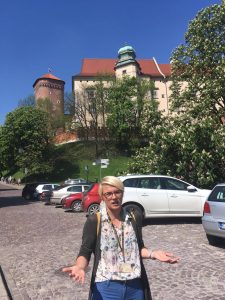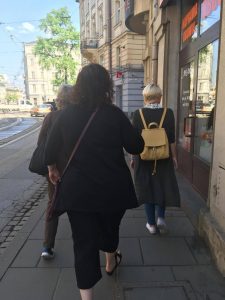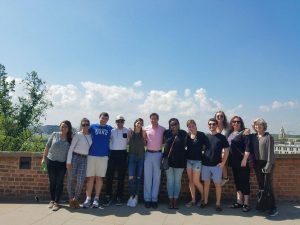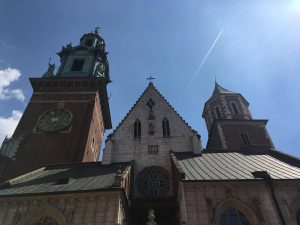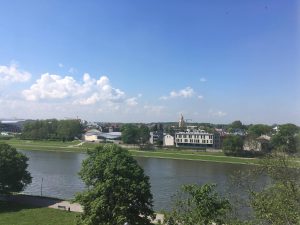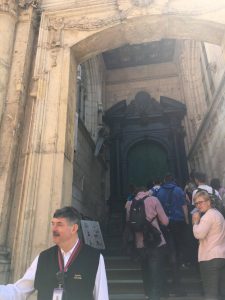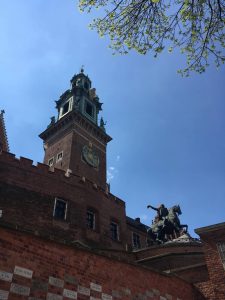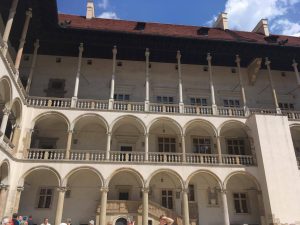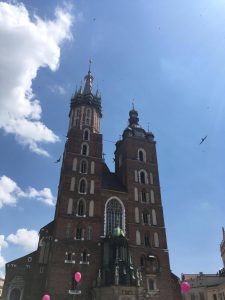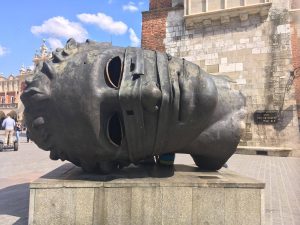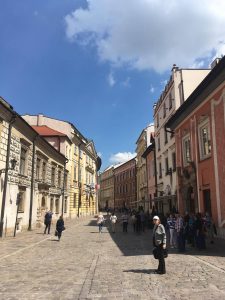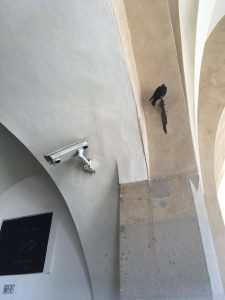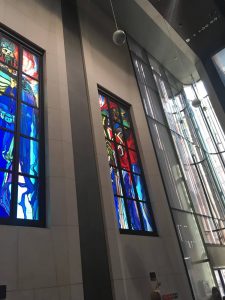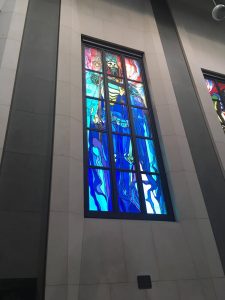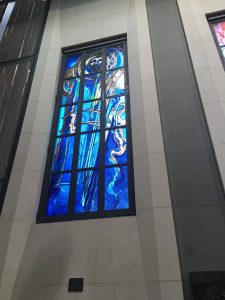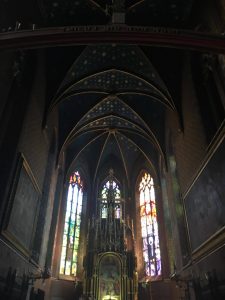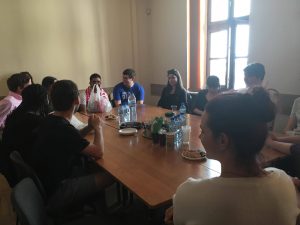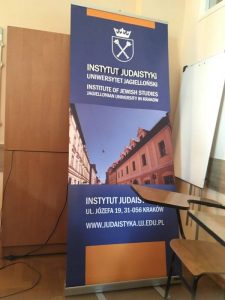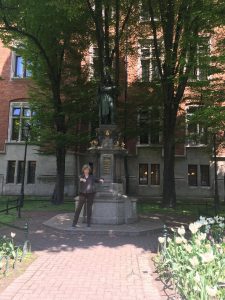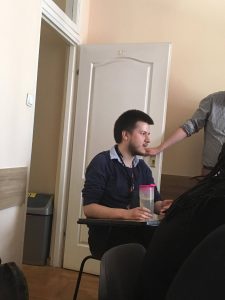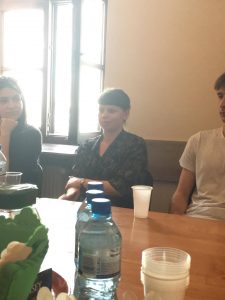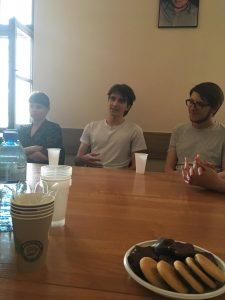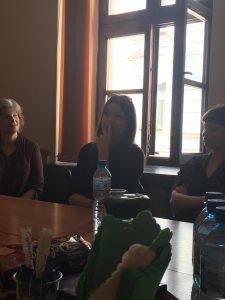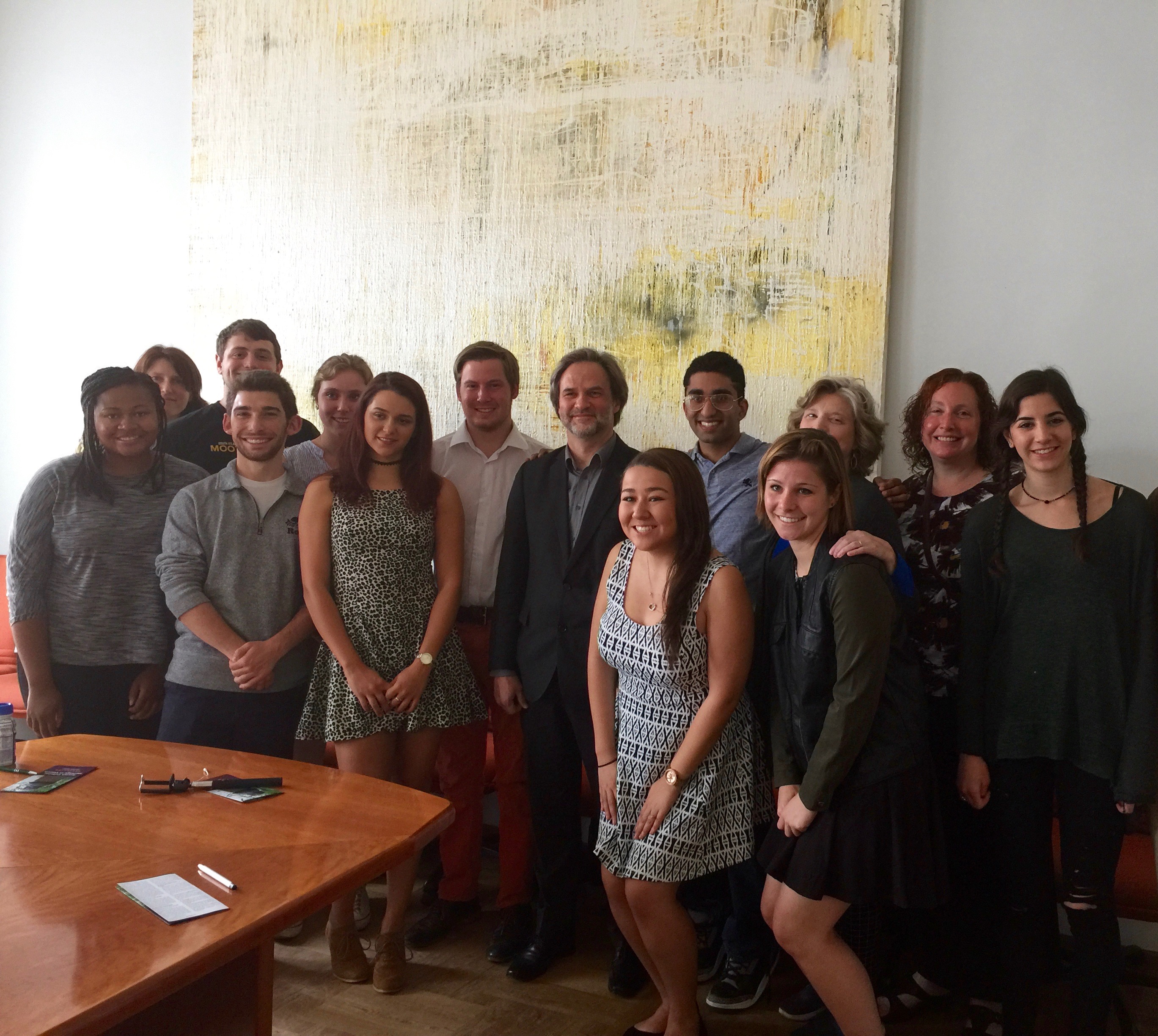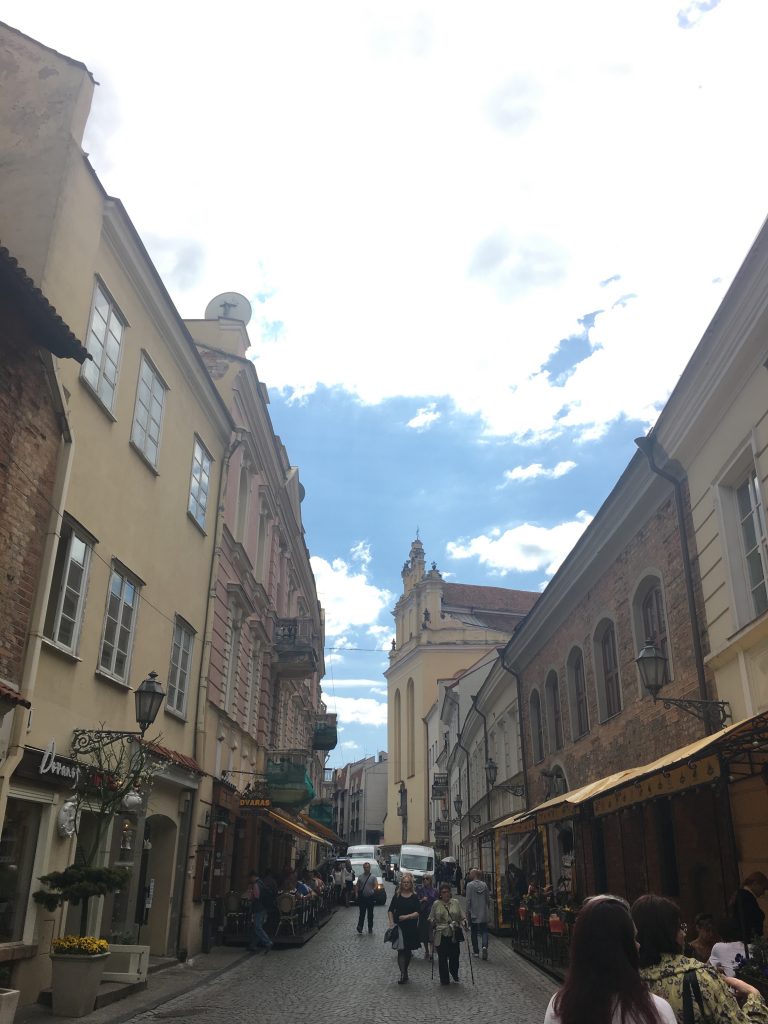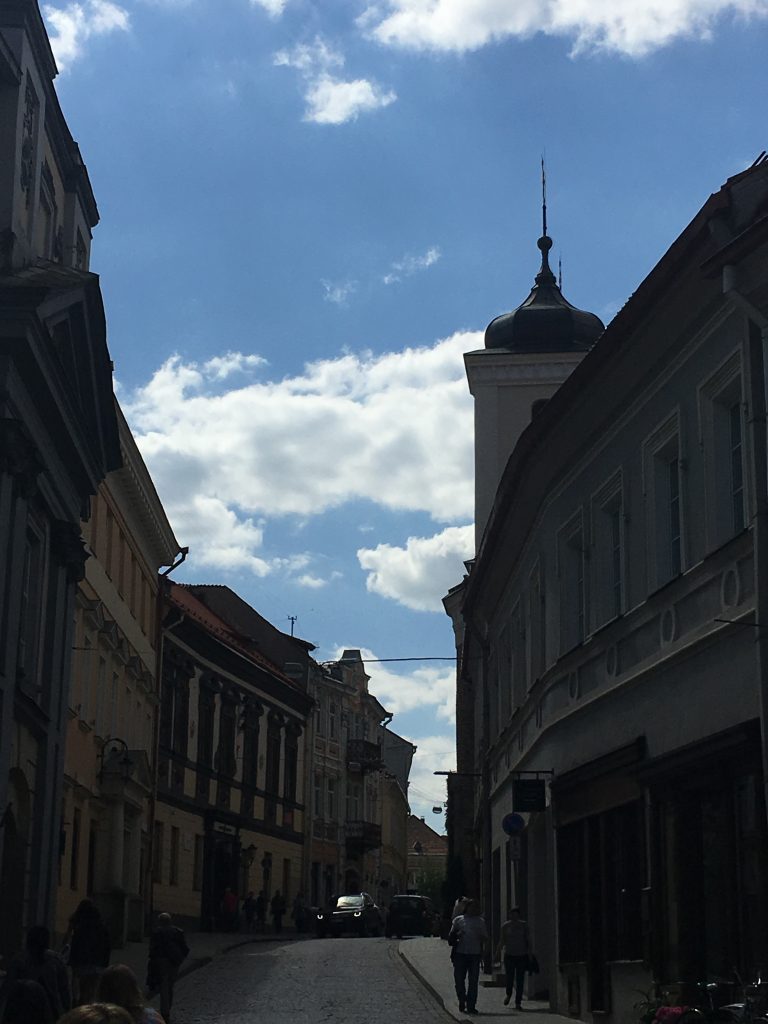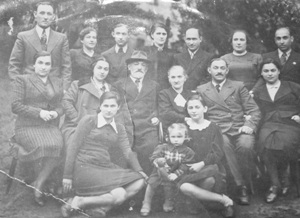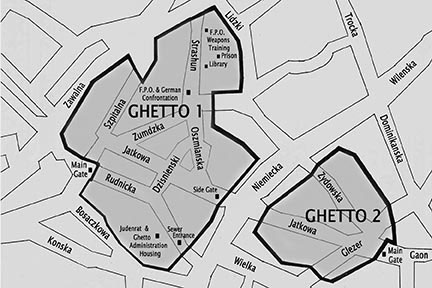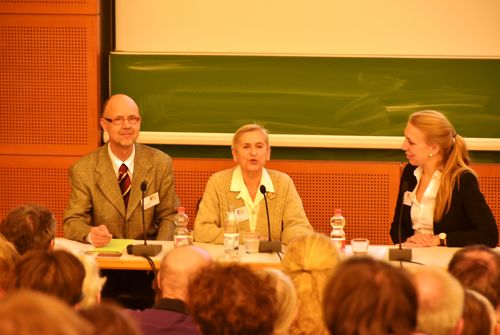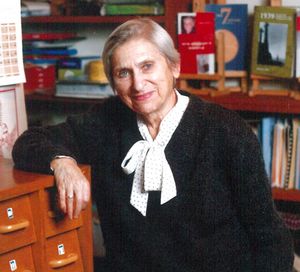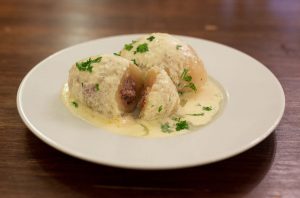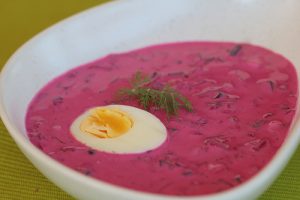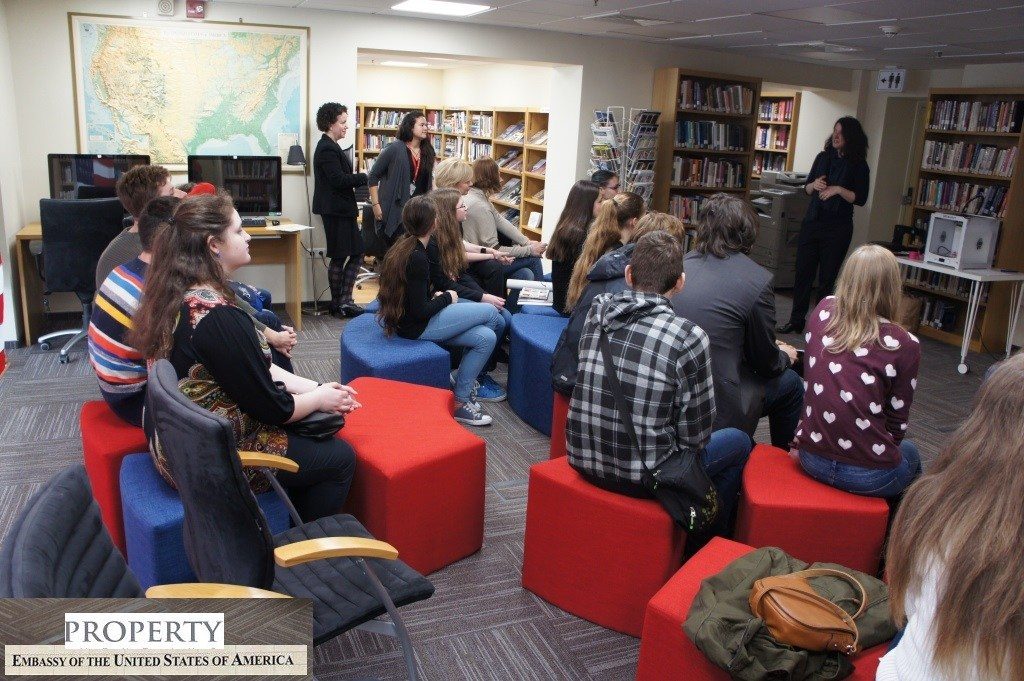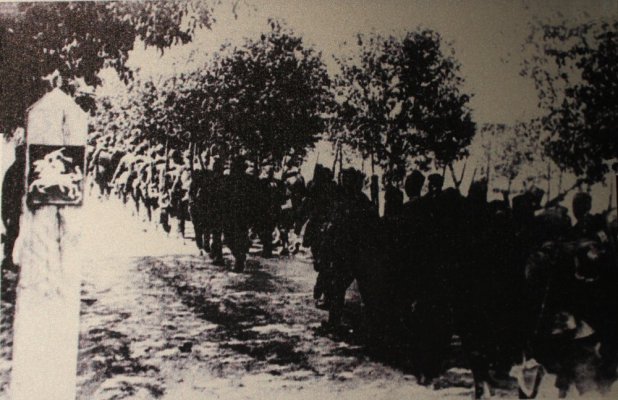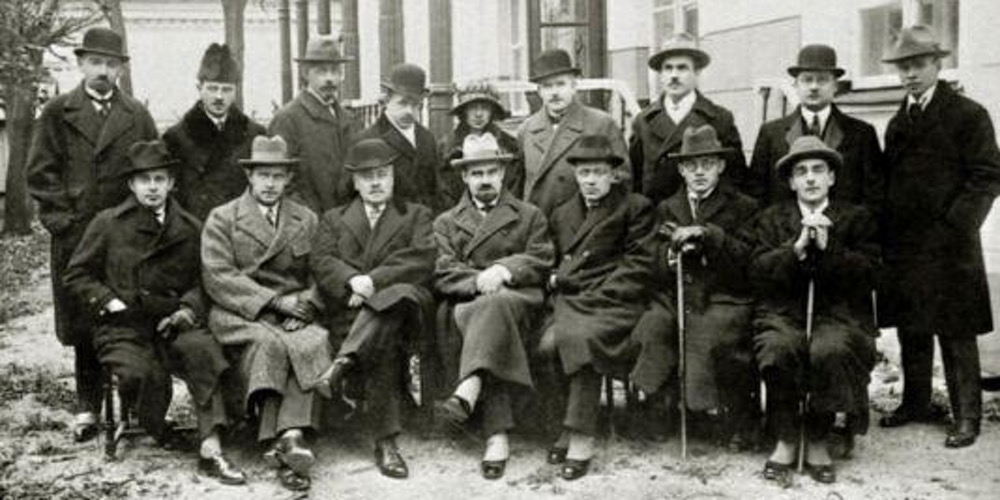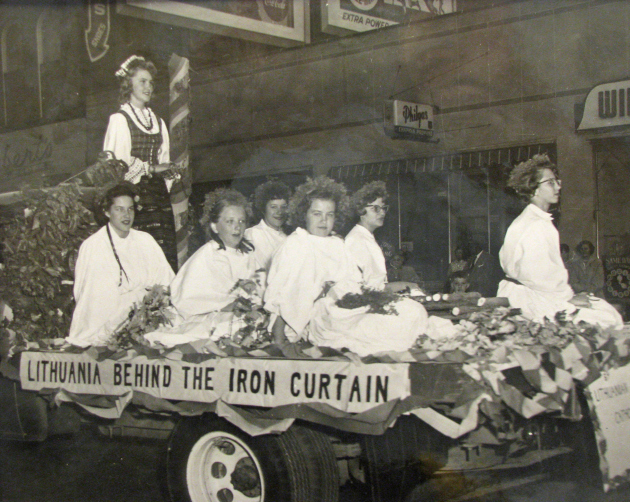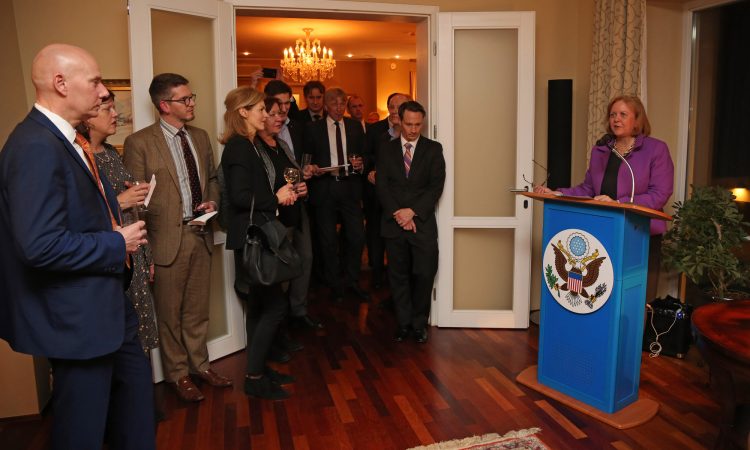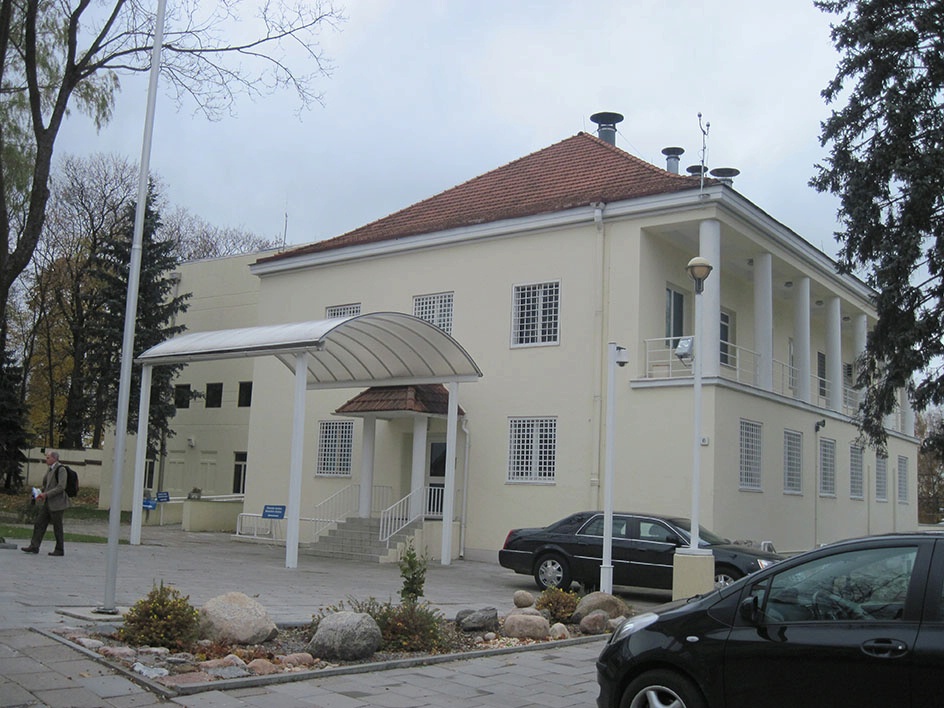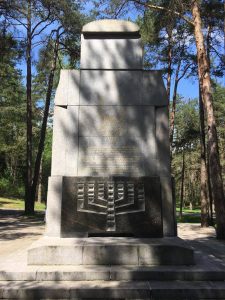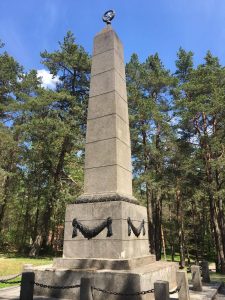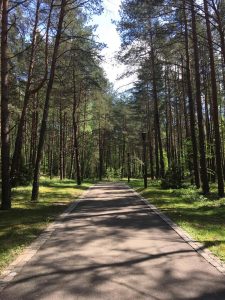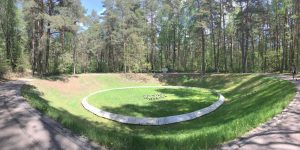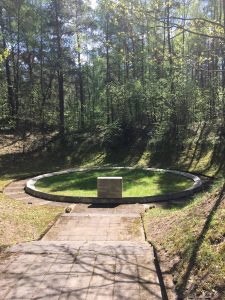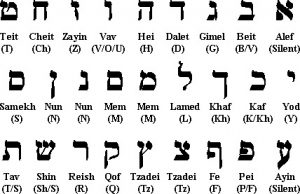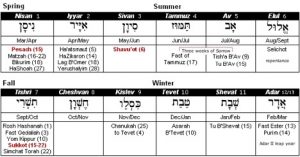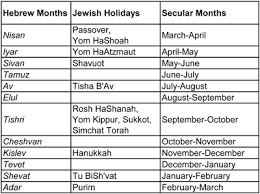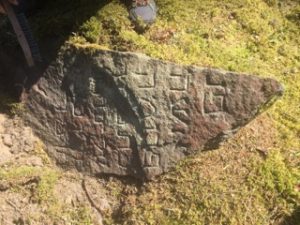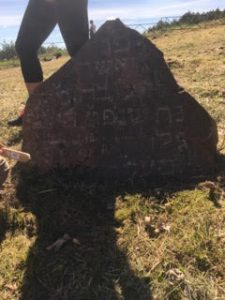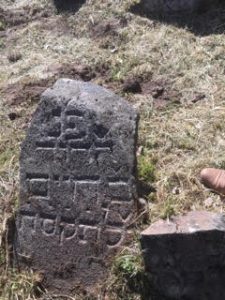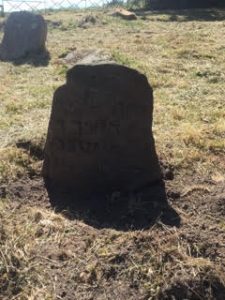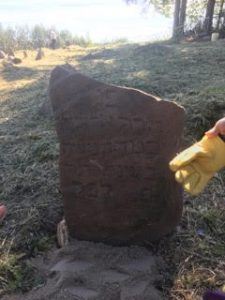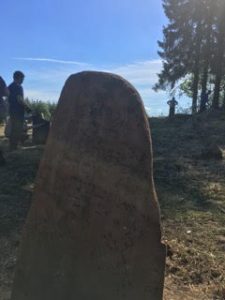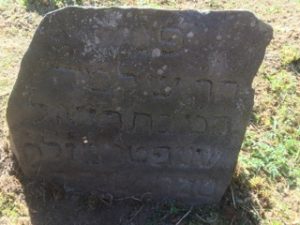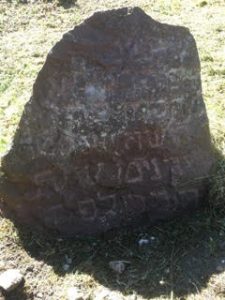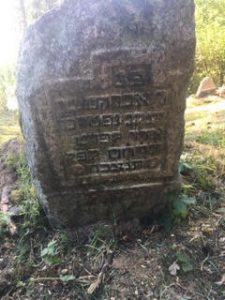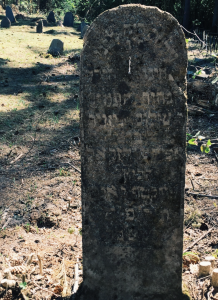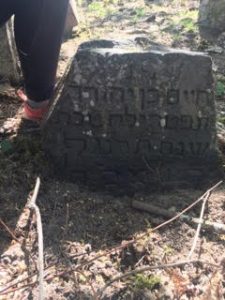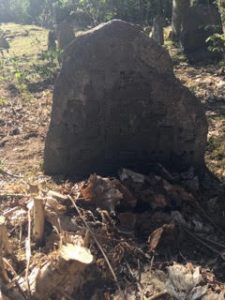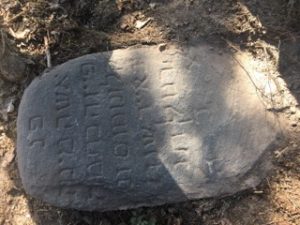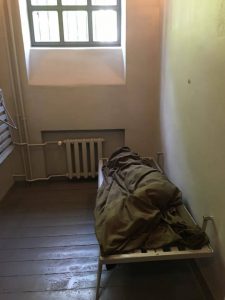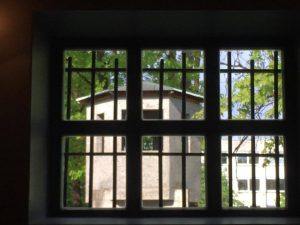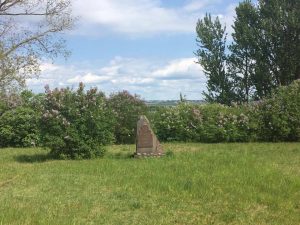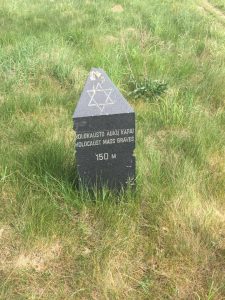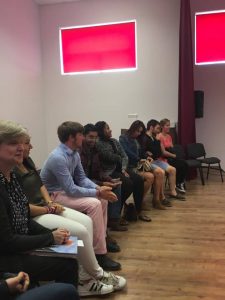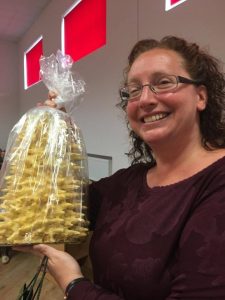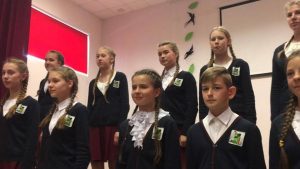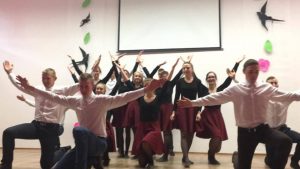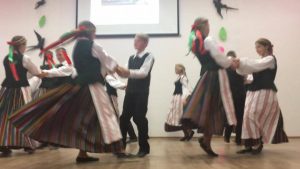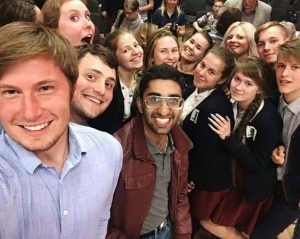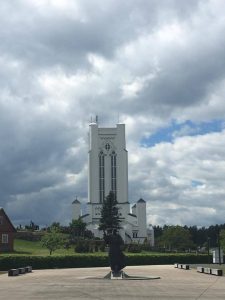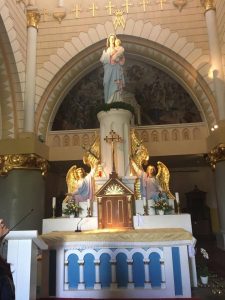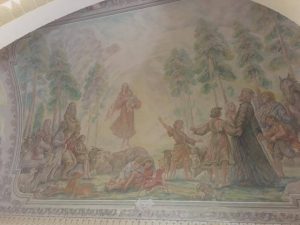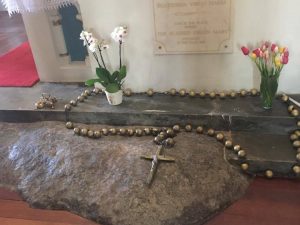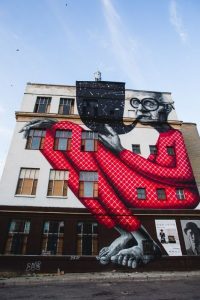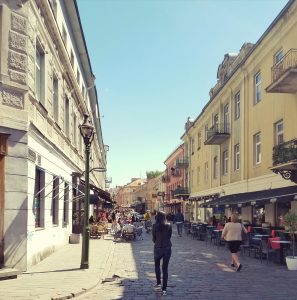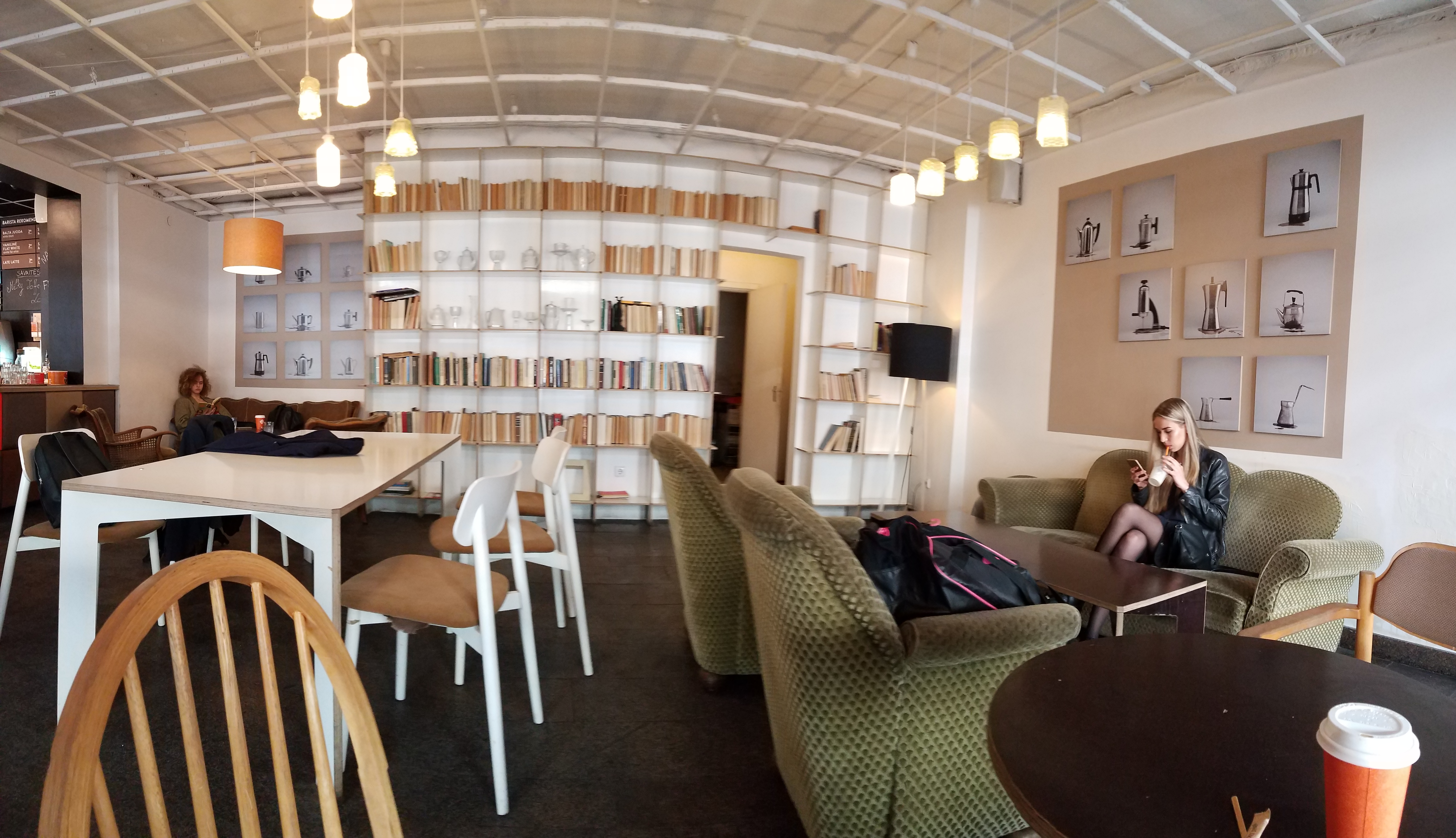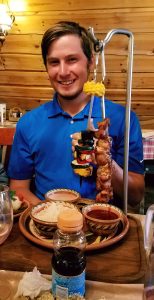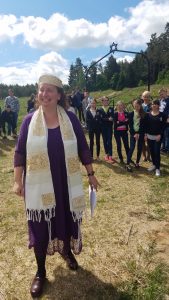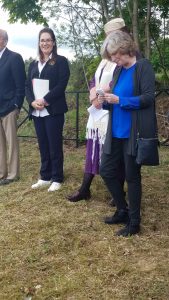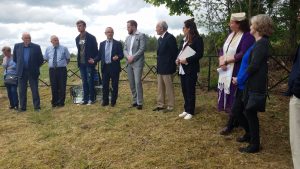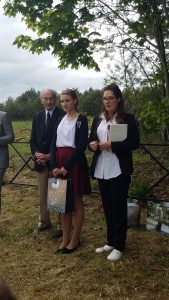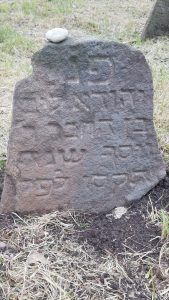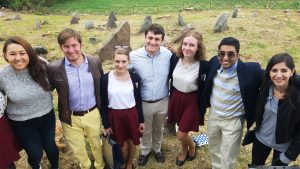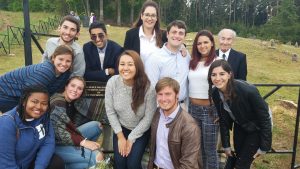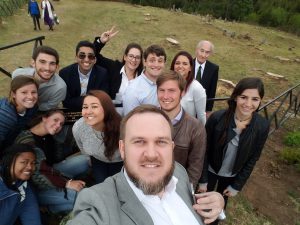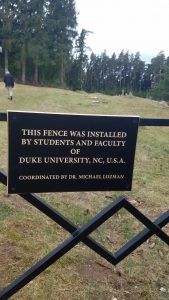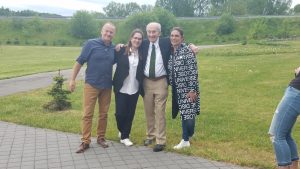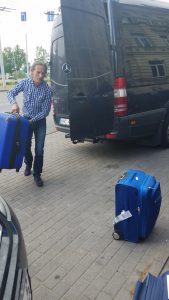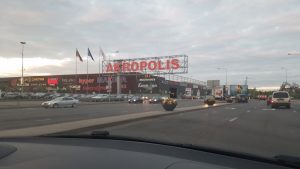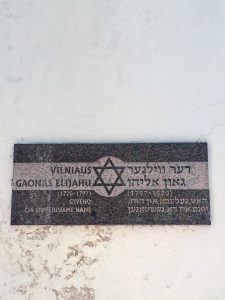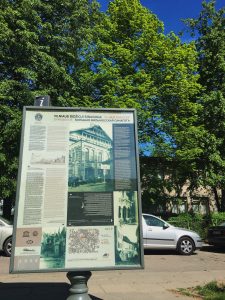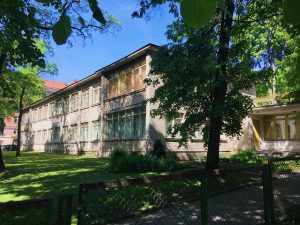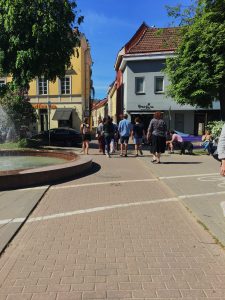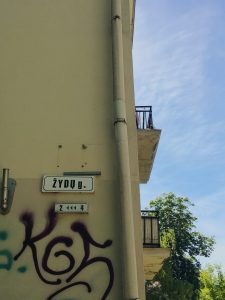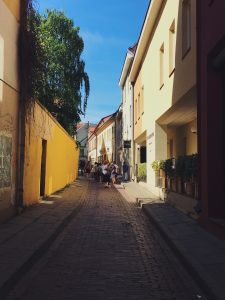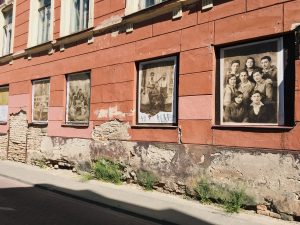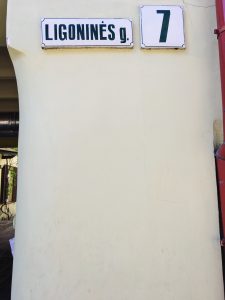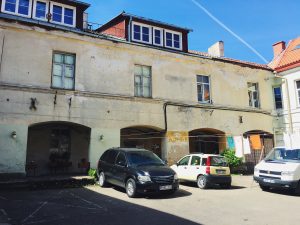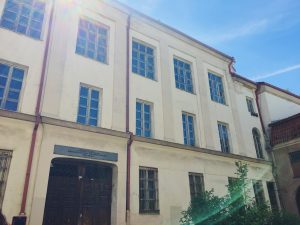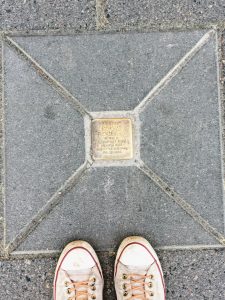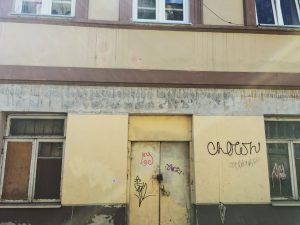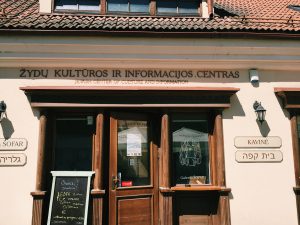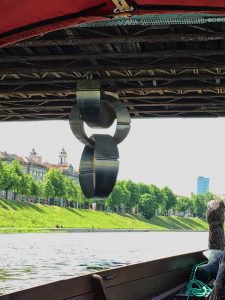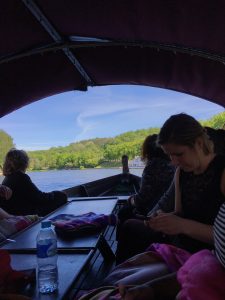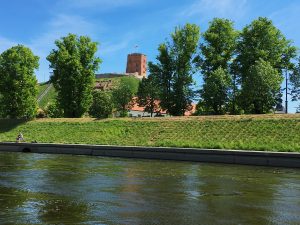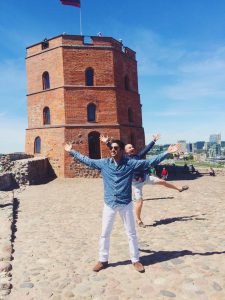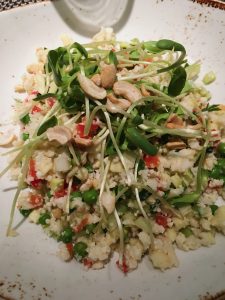By Jamie Cohen
Today, our group woke up early to drive from Kazimierz to the Auschwitz concentration camp in the town of Oswiecim. Oswiecim, the town’s Polish name, was largely a Jewish shtetl prior to the holocaust. During our drive to the camp, local guide Elzbieta Pytlarz gave us a brief history of the town both before and after the war. Elzbieta also emphasized that we should refer to the town by its proper name, Oswiecim, and not by the name Auschwitz, which the Germans used to refer to the town during the holocaust.
Prior to visiting Auschwitz, everyone in our class had learned about the camp and the unthinkable horrors that went on within it. Auschwitz-Birkenau was the main mass extermination camp of the Nazis where over a million Jews were tortured and murdered along with tens of thousands of Polish Catholics, POWs, Roma, and Sinti. While we all expected today to be a long and difficult day, we also recognized the value in visiting Auschwitz and seeing the camp with our own eyes. None of us knew how we would react to seeing the sites of murder, separation, and starvation for hundreds of thousands of Jews, but we felt well prepared for our visit having learned the appropriate background knowledge throughout the semester.
Auschwitz I
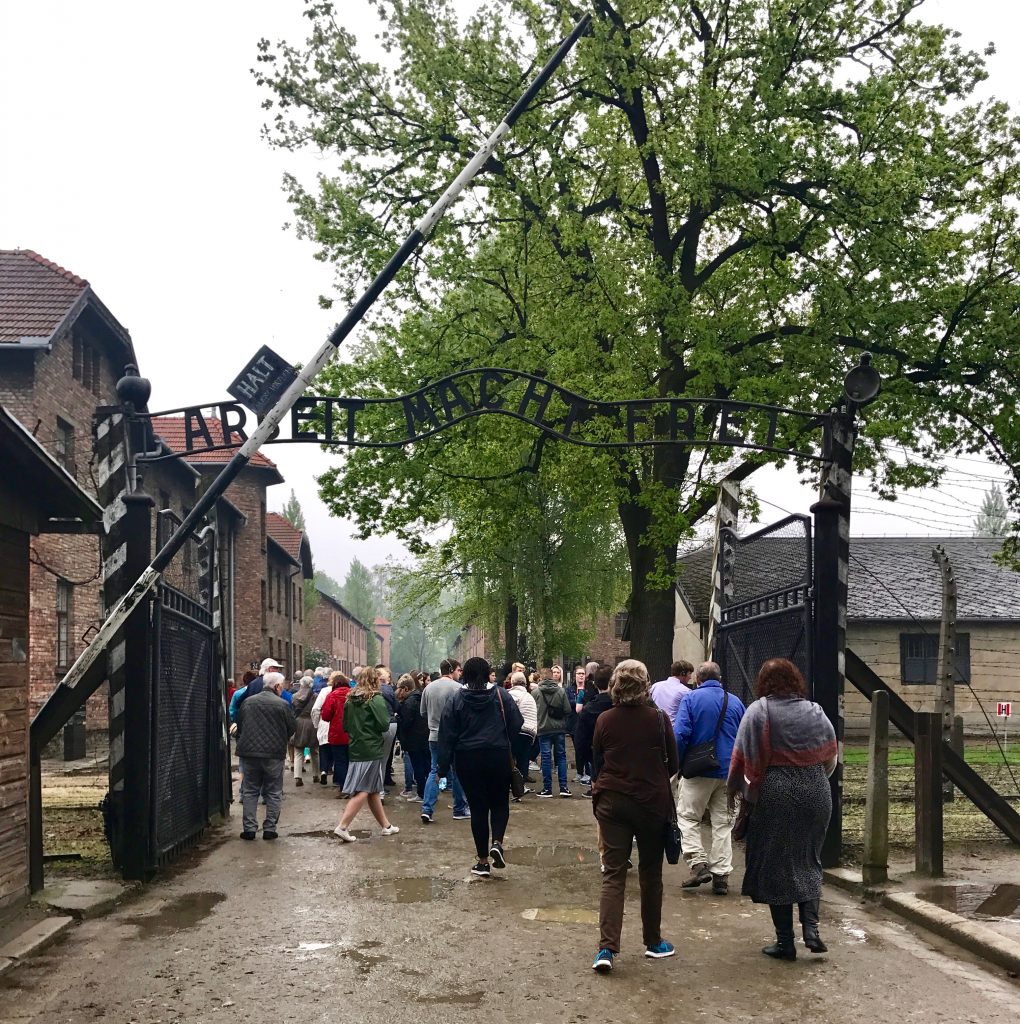 Above, you can see the infamous Arbeit Macht Frei sign, whose words mean “Work Sets You Free,” at the entrance to Auschwitz I. From the years 1940 to 1945, approximately 1,300,000 people walked through this wrought iron gate and into Auschwitz—1,100,000 of them were Jews. While I walked through this gate myself, I thought about how little the jews knew about the nature of Auschwitz and their grim futures. The few jews who had heard the rumors of extermination within the camp generally did not believe what they had heard was true. Andrew said that one of the hardest parts about visiting Auschwitz for him was walking back out of the gate and thinking about how many prisoners did not get to do so.
Above, you can see the infamous Arbeit Macht Frei sign, whose words mean “Work Sets You Free,” at the entrance to Auschwitz I. From the years 1940 to 1945, approximately 1,300,000 people walked through this wrought iron gate and into Auschwitz—1,100,000 of them were Jews. While I walked through this gate myself, I thought about how little the jews knew about the nature of Auschwitz and their grim futures. The few jews who had heard the rumors of extermination within the camp generally did not believe what they had heard was true. Andrew said that one of the hardest parts about visiting Auschwitz for him was walking back out of the gate and thinking about how many prisoners did not get to do so.
 Auschwitz was the largest Nazi German concentration camp and death camp. The Nazis deported 1,300,000 people to Auschwitz from all over:
Auschwitz was the largest Nazi German concentration camp and death camp. The Nazis deported 1,300,000 people to Auschwitz from all over:
- 1,100,000 Jews
- 140,000-150,000 Poles
- 23,000 Roma (Gypsies)
- 15,000 Soviet Prisoners of War
- 25,000 Prisoners of Other Ethnic Groups
1,000,000 of these people died in Auschwitz. Approximately 90% of the victims were jews. The SS murdered the majority of them in the gas chambers. This top picture shows the layout of Auschwitz-Birkenau. The bottom picture demonstrates just how far away the Nazis were able to take prisoners and send them to Auschwitz. The diagrams above can be found at the beginning of one’s tour of Auschwitz and serve to remind visitors that the Nazi’s “final solution” was a truly a universal plan to kill everyone they deemed inferior.
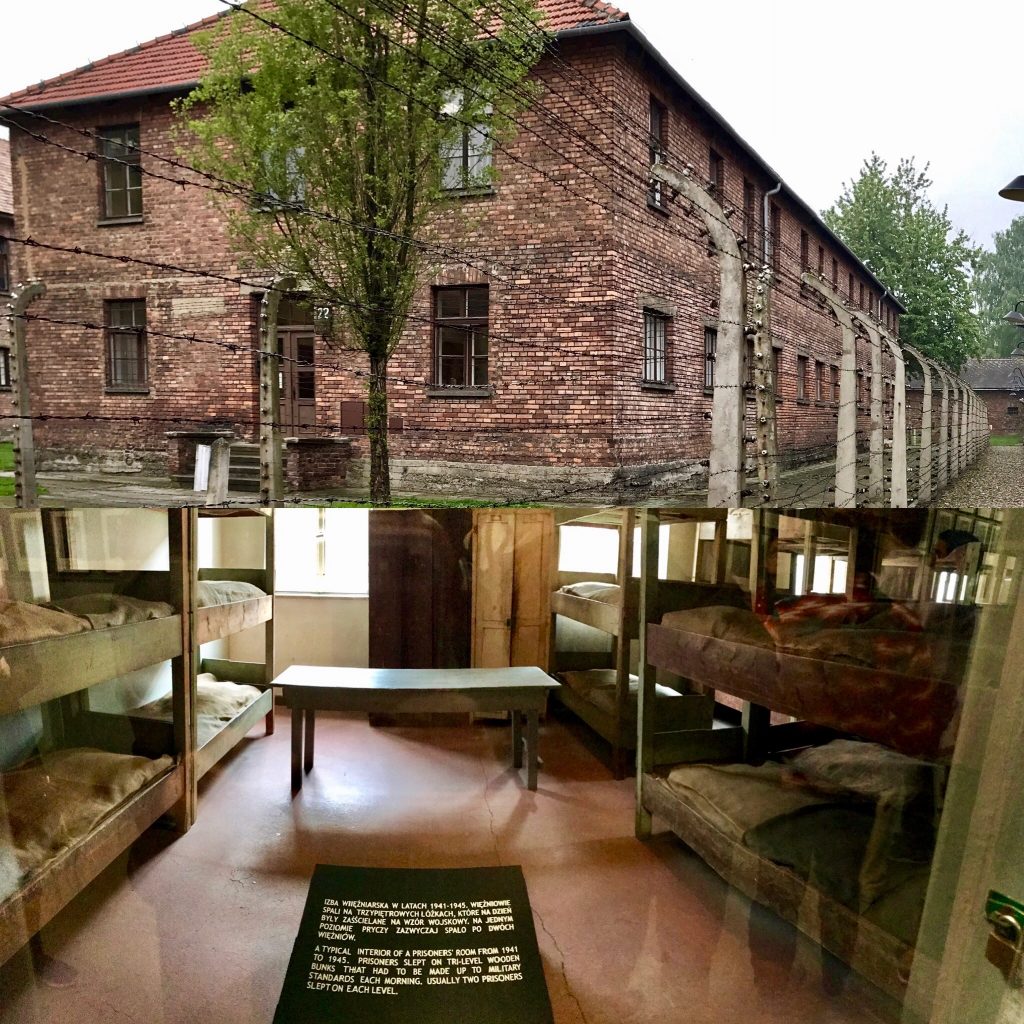 When the construction of Auschwitz I reached completion in 1942, the complex had 28 two-story brick buildings. Each building, also known as a block, housed around 1,000 prisoners. The top picture shows a reconstructed version of one of these buildings. The bottom picture depicts what the building’s interior would have looked like at the time. Prisoners slept on tri-level wooden bunks—two prisoners generally slept on each level.
When the construction of Auschwitz I reached completion in 1942, the complex had 28 two-story brick buildings. Each building, also known as a block, housed around 1,000 prisoners. The top picture shows a reconstructed version of one of these buildings. The bottom picture depicts what the building’s interior would have looked like at the time. Prisoners slept on tri-level wooden bunks—two prisoners generally slept on each level.
 Extermination in Auschwitz started in 1942. The primary method was through gas chambers, which prisoners willingly entered under the impression that they were going to take a shower. In reality, the underground room was locked once all prisoners were inside, and the poison Zyklon B was poured into the room through holes in the roof. Twenty minutes later, everyone inside had suffocated to death. The photo collage above depicts the inside of the gas chamber, the empty/used containers of Zyklon B, and what the outside of the gas chamber looked like from above ground. For me, the hardest part of visiting Auschwitz was standing inside the gas chamber. Because the gas chambers were all underground, I felt very claustrophobic while inside and was truly relieved once I got to walk back up the stairs.
Extermination in Auschwitz started in 1942. The primary method was through gas chambers, which prisoners willingly entered under the impression that they were going to take a shower. In reality, the underground room was locked once all prisoners were inside, and the poison Zyklon B was poured into the room through holes in the roof. Twenty minutes later, everyone inside had suffocated to death. The photo collage above depicts the inside of the gas chamber, the empty/used containers of Zyklon B, and what the outside of the gas chamber looked like from above ground. For me, the hardest part of visiting Auschwitz was standing inside the gas chamber. Because the gas chambers were all underground, I felt very claustrophobic while inside and was truly relieved once I got to walk back up the stairs.
Auschwitz II-Birkenau
 As Auschwitz I became overcrowded, the SS authorities started having the prisoners build Auschwitz II, otherwise known as Birkenau. Birkenau, which was 20 times larger than Auschwitz I, was broken up into three different parts: Birkenau I, Birkenau II, and Birkenau III. The top picture above shows the entrance to Birkenau; the bottom picture, the barracks within Birkenau.
As Auschwitz I became overcrowded, the SS authorities started having the prisoners build Auschwitz II, otherwise known as Birkenau. Birkenau, which was 20 times larger than Auschwitz I, was broken up into three different parts: Birkenau I, Birkenau II, and Birkenau III. The top picture above shows the entrance to Birkenau; the bottom picture, the barracks within Birkenau.

The picture above shows a reconstruction of one of the cattle car wagons which brought prisoners from all over the continent to the camp. In one cattle car wagon, between 60 and 80 people were squashed together without food and water for up to a week. When the trains finally arrived at the camps, everyone was told to leave their belongings on board. The prisoners were then forced to disembark the train and gather on the railway platform for selection. Many of my peers said that standing on the unloading ramp in Birkenau and walking past the reconstructed cattle car wagon was the hardest part of the visit to Auschwitz for them. Dan explained that walking along the unloading ramp was challenging because it was the place where “the journey ended for so many and hundreds of thousands were separated from the family and friends they loved.”
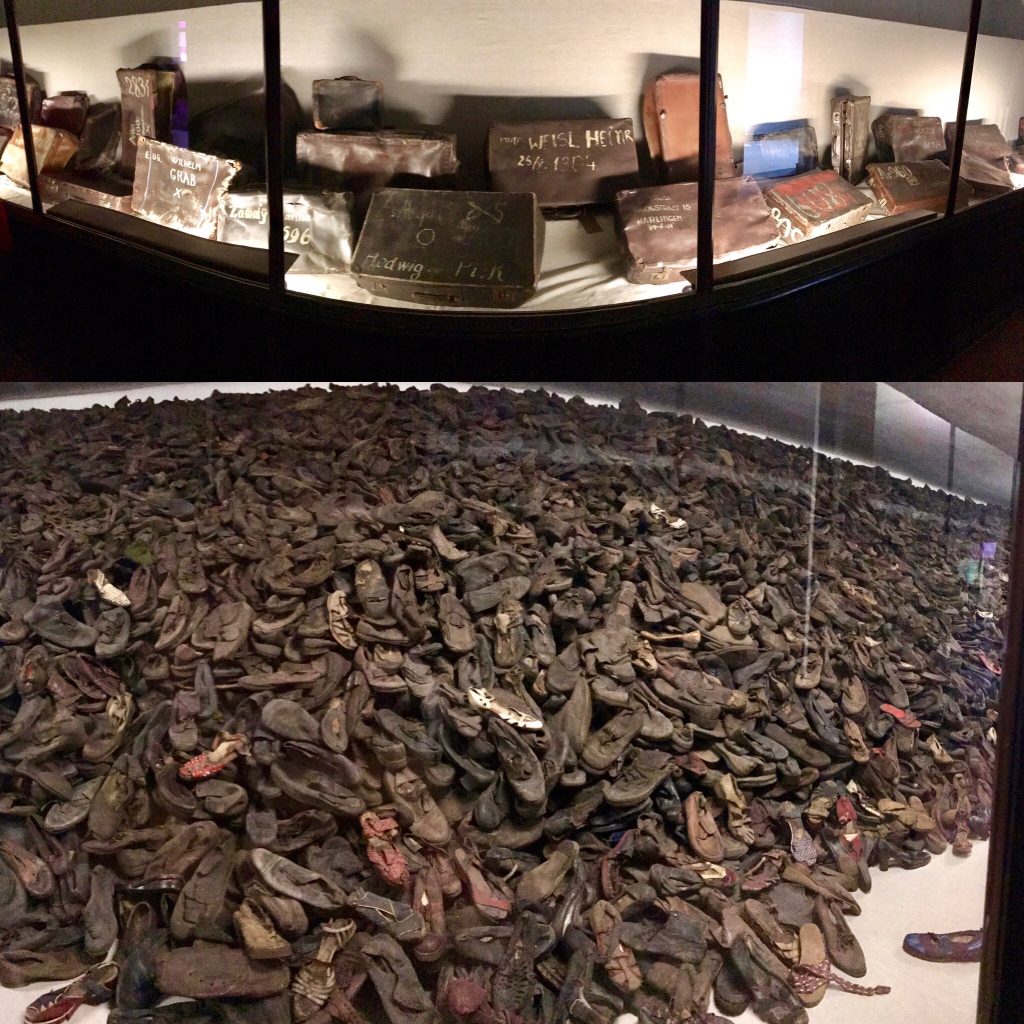
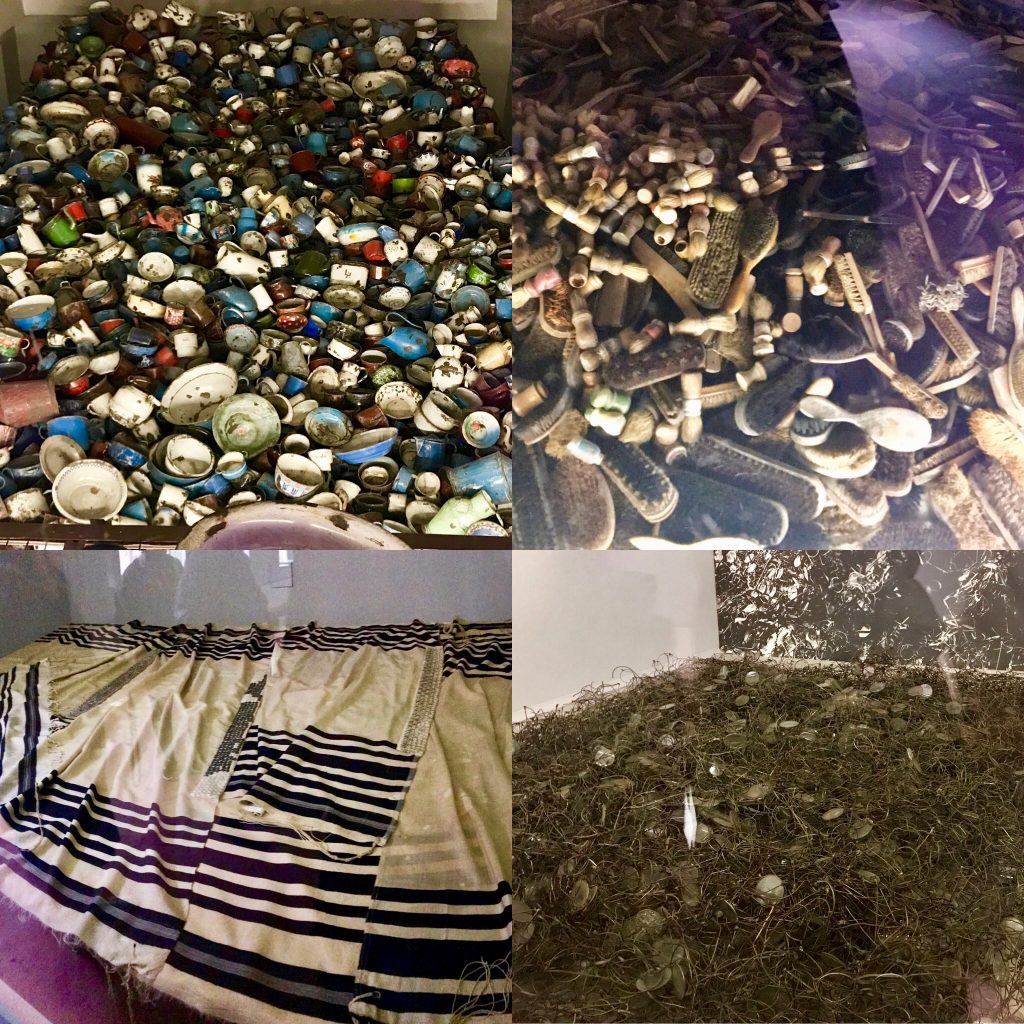
When people arrived at Auschwitz-Birkenau, they had no idea what to expect and carried with them all sorts of belongings. Once at Auschwitz, however, the SS officers would confiscate all suitcases and send them to Kanada I and II. At Kanada I and II, Nazi officers would go through the suitcases and send many of the belongings to the 3rd Reich in order to promote the German war effort. While the Nazis attempted to burn Kanada I and Kanda II at the end of the war and erase the concrete evidence of their wrongdoings, they were unable to destroy all of the prisoner’s belongings. The picture above shows just some of the belongings of the prisoners of Auschwitz which were not destroyed.
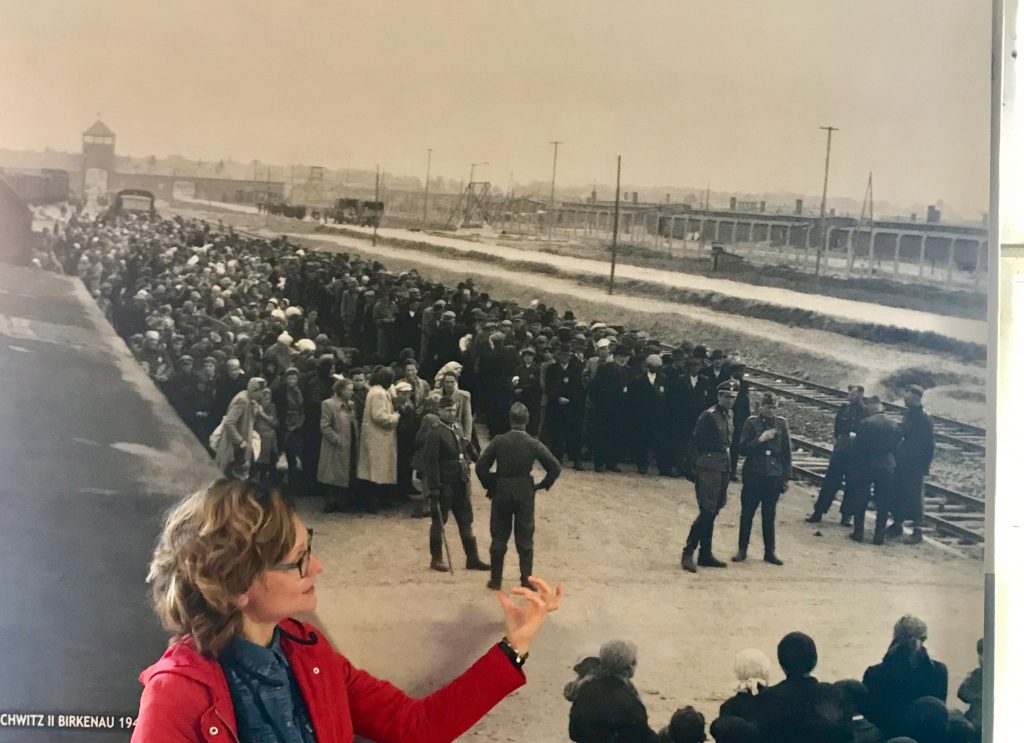
Above is a picture of the selection process which the Nazis used to separate those they believed were fit to work from those who they believed were not. The sick, weak, and old who were considered unfit to work would be sent straight to the gas chambers. Children were even sent to the gas chambers—approximately 200,000 Jewish children were gassed to death in Auschwitz. Selection, however, was a peaceful process because everyone was assured they were simply lining up to take a shower. In the context of the horrendous conditions which the prisoners endured on the cattle car wagons, showers actually made sense.
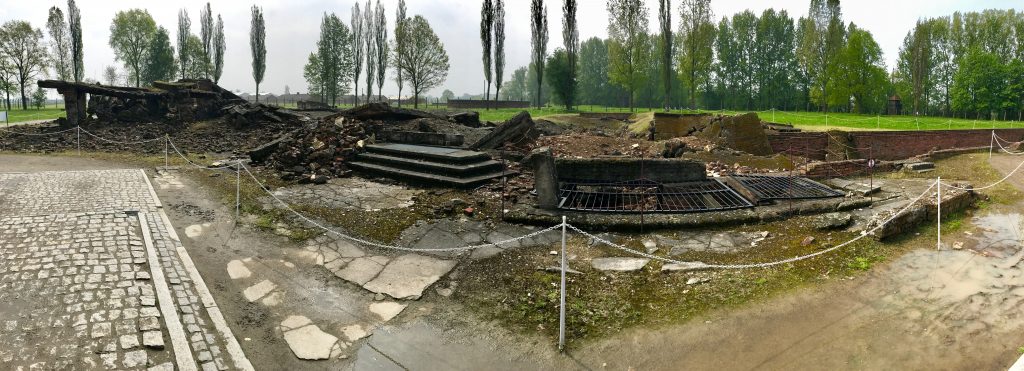
Birkenau had four main gas chambers, each had its own crematorium. Because these gas chambers were all underground, they were difficult to destroy completely at the end of the war. Above is a picture of what remains of one of the main gas chambers in Birkenau. Special prisoners who had been assigned the horrible job of Sonderkommandos worked in these gas chambers. After the Zyklon B had killed everyone inside the gas chamber, the Sonderkommandos would remove the bodies, search them for gold, and throw them into the crematoria. Sonderkommandos would often recognize their own family members and friends among the dead bodies. Every so often, the Nazis would also kill the Sonderkommandos because they had witnessed too much of the killing process. However, several Sonderkommandos survived the holocaust and were invaluable to recounting the Nazi operations within the camp.
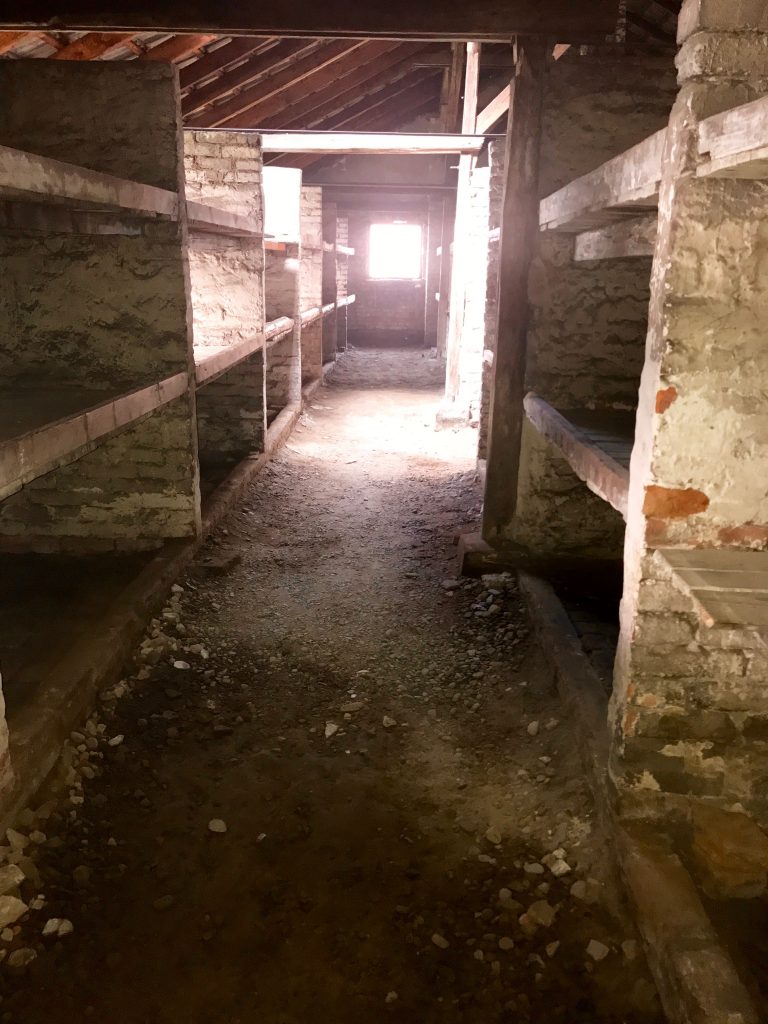
Because Birkenau was primarily a death camp and not a work camp, the majority of the mass killings took place in Birkenau. While people could sometimes survive a year in Auschwitz I, it was uncommon for an individual to live longer than three months in Birkenau. The picture above shows the women’s barracks in Birkenau, where women merely waited to die.
The Oswiecim Synagogue
Following our tour of Auschwitz I and Birkenau, we drove to the Oswiecim Synagogue. The Oswiecim Synagogue, also known as the Auschwitz Synagogue, is the only active synagogue in the town of Oscwiecim. At the time of the Nazi invasion, more than half the population of Oscwiecim was Jewish. The Jewish community of the town was over 400 years old, and there were more than 20 synagogues in Oswiecim. The Oswiecim Synagogue was the first building restored to the Jewish community under the Polish government’s post-Communism law governing the restitution of Jewish communal property seized by German occupiers during WWII and retained by the post-war Communist government. The synagogue was built in 1913, but the Nazis demolished its interior and used it to house munition during the war. In 2000, the synagogue was completely restored to its pre-war condition, and the adjoining house was turned into a museum which depicts the life of Jews in pre-war Oswiecim.
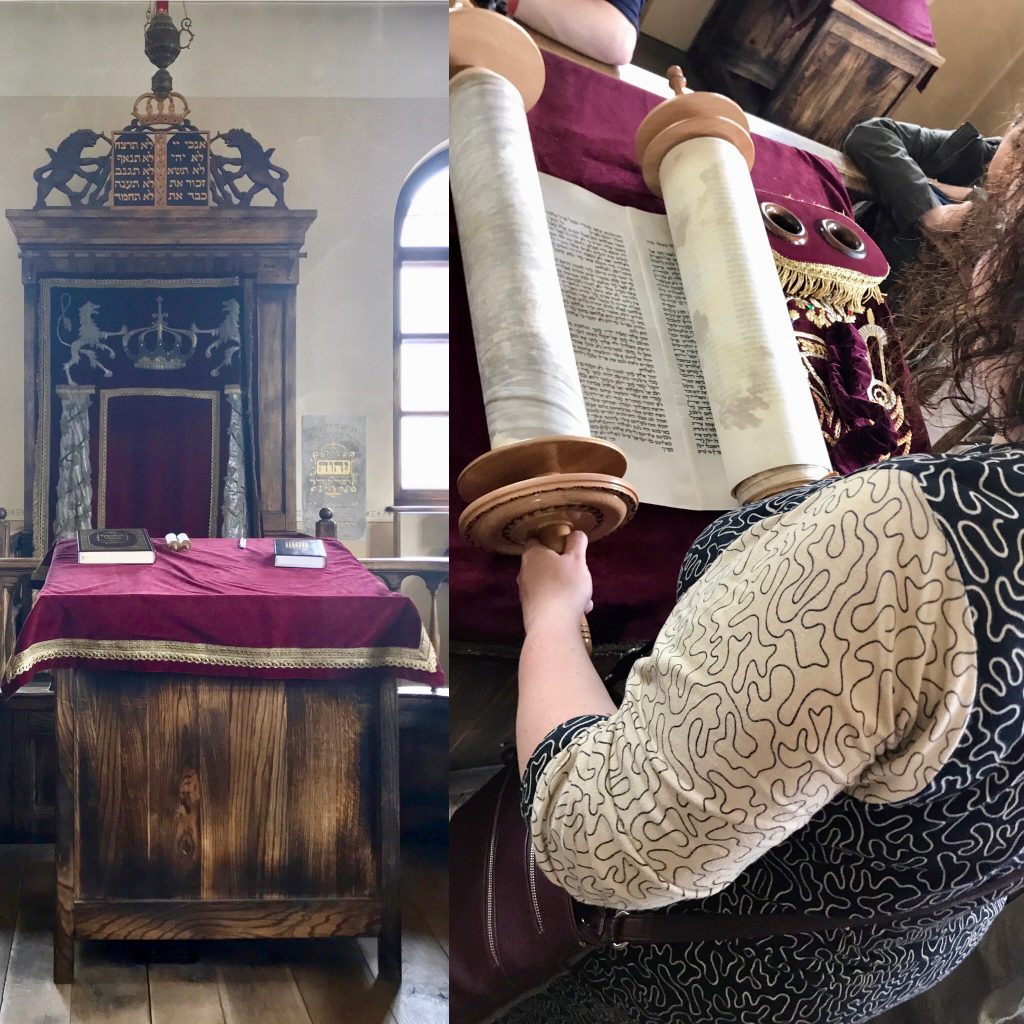
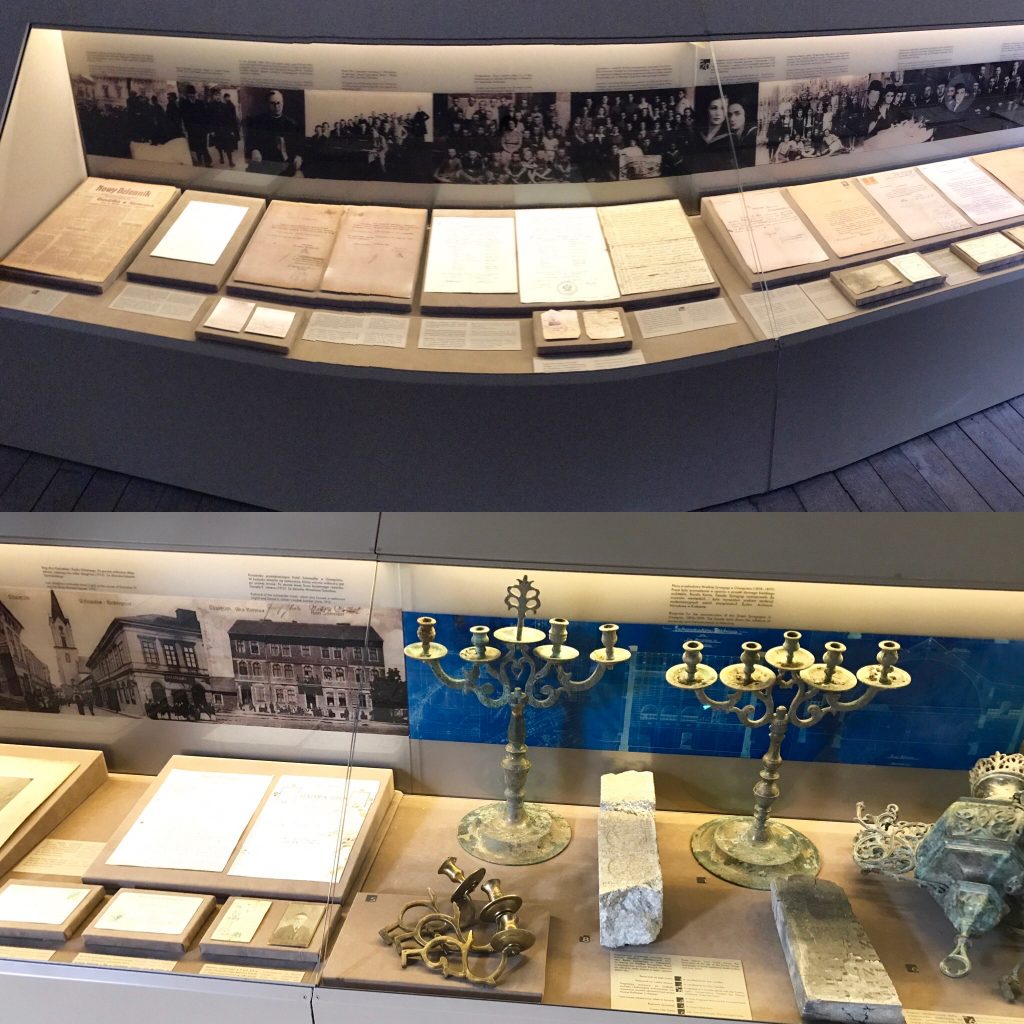
The first picture above shows the interior of the synagogue as well as the torah it houses; the second picture above depicts a portion of the museum attached to the synagogue. While the town of Oswiecim no longer has a Jewish population, the synagogue is still active and often used for prayers by groups and individuals visiting Auschwitz. Our class truly enjoyed visiting this synagogue and felt it was the perfect place to go following our visit to Auschwitz. The synagogue reminded us that while the holocaust stole the lives of so many jews, it did not end all Jewish life. Many of my classmates even wished we had spent more time at the synagogue, learning about torah from Professor Lieber who had the opportunity to show us the synagogue’s torah and point out some of its key features.
Wadowice (Birthplace of Pope John Paul II)
After visiting the Oswiecim Synagogue, we drove to the town of Wadowice. Wadowice was the birthplace of Pope John Paul II. Because the town of Wadowice is close to the Auschwitz concentration camp, almost the entire town’s Jewish population (more than 2,000) was exterminated in the camp. Nevertheless, during the pontificate of John Paul II, relations between Catholicism and Judaism improved dramatically. John Paul II spoke frequently about the Church’s relationship with the Jewish faith. John Paul II was the first pope to visit Auschwitz in 1979 as well as the first pope to visit a synagogue. After reading more about the extent to which John Paul II improved relations between jews and catholics, I would agree with Michael Schudrich, chief rabbi of Poland, who said that “never in history did anyone do as much for Christian-Jewish dialogue as Pope John Paul II.”
While in Wadowice, our class took an extensive tour of the Pope’s family home. Unfortunately, very little of the tour focused on how the Pope improved relations between jews and catholics. The picture below shows the basilica dedicated to Pope John Paul II in Wadowice.
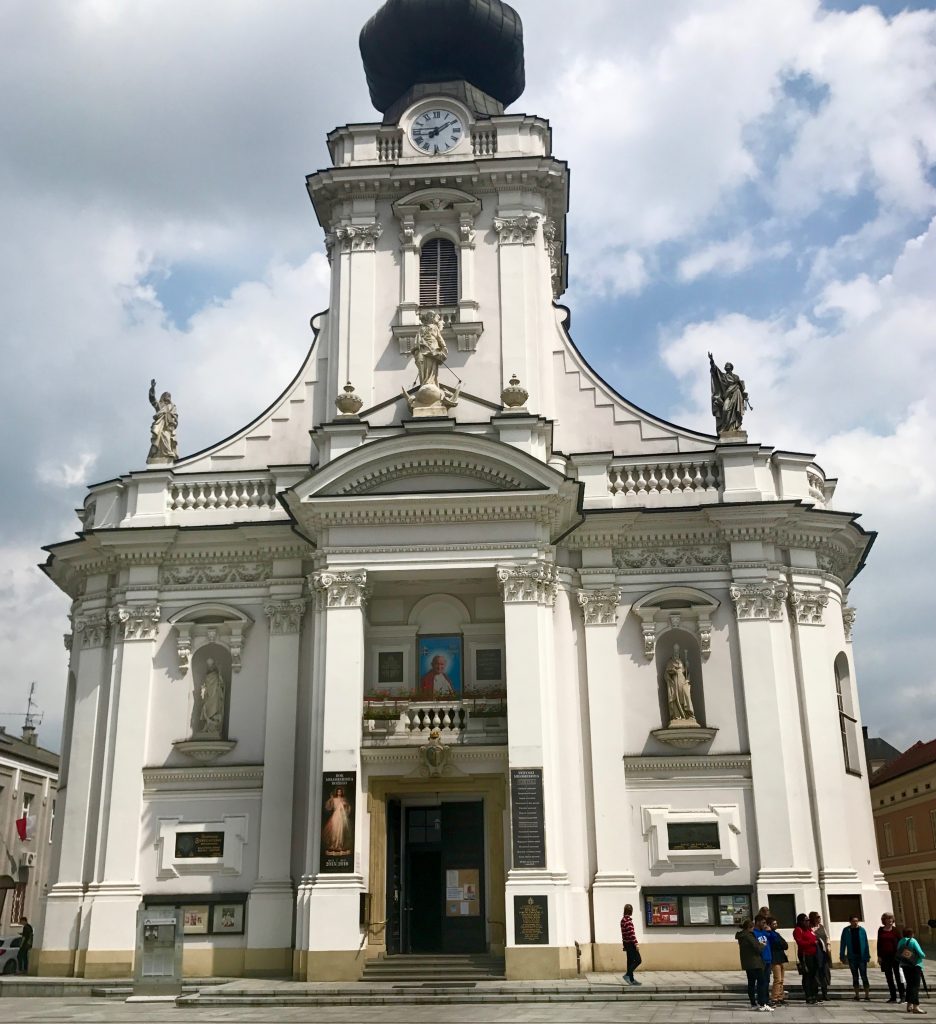
The town is also known for its Polish Papal Cream Cakes which Elzbieta insisted everyone in our class try. However, many of my classmates were not too fond of these cream cakes and gave them mixed reviews. Below is a picture of Professor Lieber and Professor Holmgren trying one of these Polish Papal cream cakes.
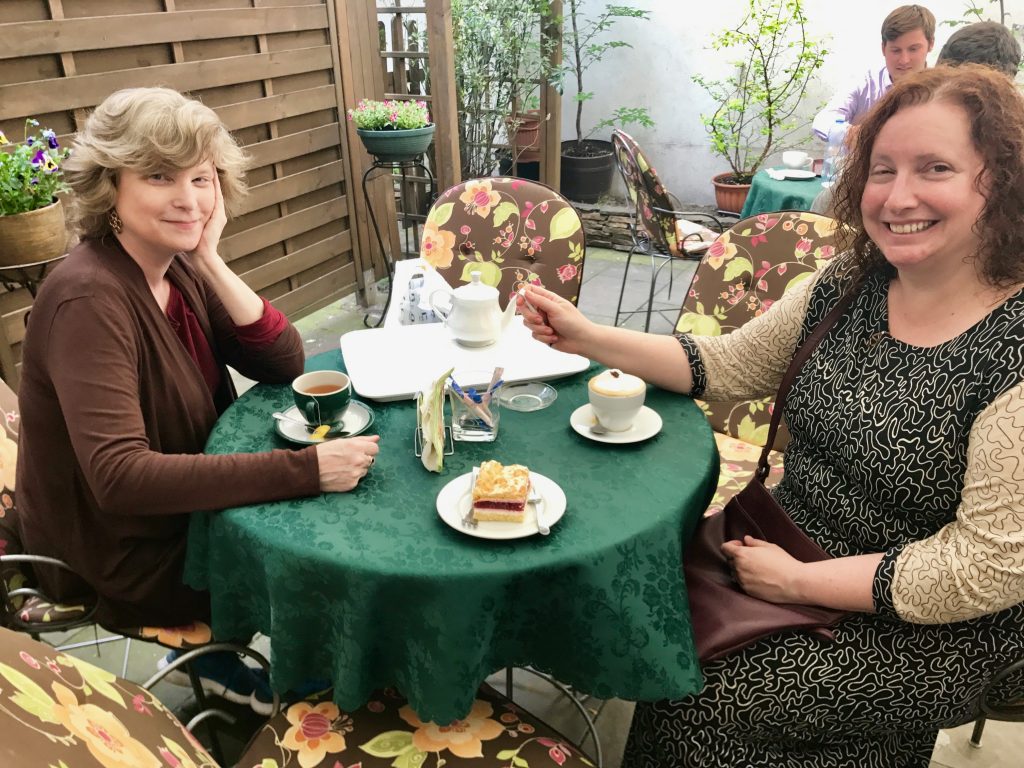
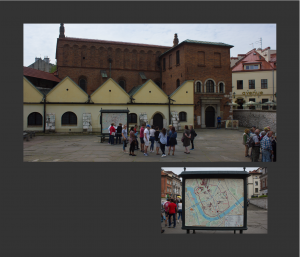
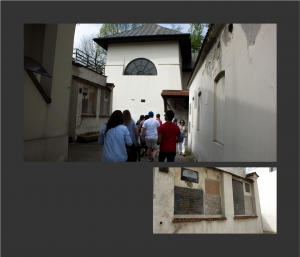


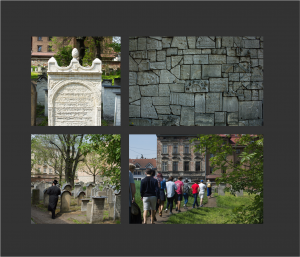
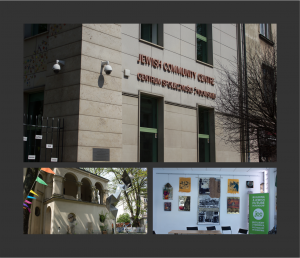
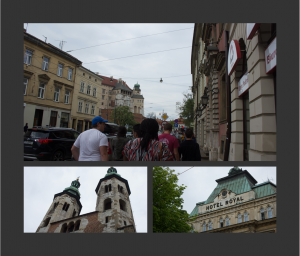
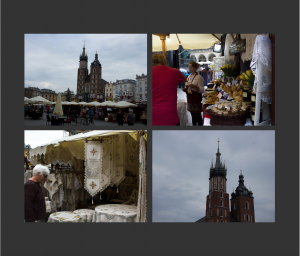

 Above, you can see the infamous Arbeit Macht Frei sign, whose words mean “Work Sets You Free,” at the entrance to Auschwitz I. From the years 1940 to 1945, approximately 1,300,000 people walked through this wrought iron gate and into Auschwitz—1,100,000 of them were Jews. While I walked through this gate myself, I thought about how little the jews knew about the nature of Auschwitz and their grim futures. The few jews who had heard the rumors of extermination within the camp generally did not believe what they had heard was true. Andrew said that one of the hardest parts about visiting Auschwitz for him was walking back out of the gate and thinking about how many prisoners did not get to do so.
Above, you can see the infamous Arbeit Macht Frei sign, whose words mean “Work Sets You Free,” at the entrance to Auschwitz I. From the years 1940 to 1945, approximately 1,300,000 people walked through this wrought iron gate and into Auschwitz—1,100,000 of them were Jews. While I walked through this gate myself, I thought about how little the jews knew about the nature of Auschwitz and their grim futures. The few jews who had heard the rumors of extermination within the camp generally did not believe what they had heard was true. Andrew said that one of the hardest parts about visiting Auschwitz for him was walking back out of the gate and thinking about how many prisoners did not get to do so. Auschwitz was the largest Nazi German concentration camp and death camp. The Nazis deported 1,300,000 people to Auschwitz from all over:
Auschwitz was the largest Nazi German concentration camp and death camp. The Nazis deported 1,300,000 people to Auschwitz from all over: When the construction of Auschwitz I reached completion in 1942, the complex had 28 two-story brick buildings. Each building, also known as a block, housed around 1,000 prisoners. The top picture shows a reconstructed version of one of these buildings. The bottom picture depicts what the building’s interior would have looked like at the time. Prisoners slept on tri-level wooden bunks—two prisoners generally slept on each level.
When the construction of Auschwitz I reached completion in 1942, the complex had 28 two-story brick buildings. Each building, also known as a block, housed around 1,000 prisoners. The top picture shows a reconstructed version of one of these buildings. The bottom picture depicts what the building’s interior would have looked like at the time. Prisoners slept on tri-level wooden bunks—two prisoners generally slept on each level. Extermination in Auschwitz started in 1942. The primary method was through gas chambers, which prisoners willingly entered under the impression that they were going to take a shower. In reality, the underground room was locked once all prisoners were inside, and the poison Zyklon B was poured into the room through holes in the roof. Twenty minutes later, everyone inside had suffocated to death. The photo collage above depicts the inside of the gas chamber, the empty/used containers of Zyklon B, and what the outside of the gas chamber looked like from above ground. For me, the hardest part of visiting Auschwitz was standing inside the gas chamber. Because the gas chambers were all underground, I felt very claustrophobic while inside and was truly relieved once I got to walk back up the stairs.
Extermination in Auschwitz started in 1942. The primary method was through gas chambers, which prisoners willingly entered under the impression that they were going to take a shower. In reality, the underground room was locked once all prisoners were inside, and the poison Zyklon B was poured into the room through holes in the roof. Twenty minutes later, everyone inside had suffocated to death. The photo collage above depicts the inside of the gas chamber, the empty/used containers of Zyklon B, and what the outside of the gas chamber looked like from above ground. For me, the hardest part of visiting Auschwitz was standing inside the gas chamber. Because the gas chambers were all underground, I felt very claustrophobic while inside and was truly relieved once I got to walk back up the stairs. As Auschwitz I became overcrowded, the SS authorities started having the prisoners build Auschwitz II, otherwise known as Birkenau. Birkenau, which was 20 times larger than Auschwitz I, was broken up into three different parts: Birkenau I, Birkenau II, and Birkenau III. The top picture above shows the entrance to Birkenau; the bottom picture, the barracks within Birkenau.
As Auschwitz I became overcrowded, the SS authorities started having the prisoners build Auschwitz II, otherwise known as Birkenau. Birkenau, which was 20 times larger than Auschwitz I, was broken up into three different parts: Birkenau I, Birkenau II, and Birkenau III. The top picture above shows the entrance to Birkenau; the bottom picture, the barracks within Birkenau. 









